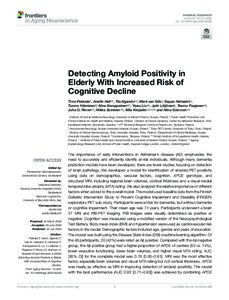Detecting Amyloid Positivity in Elderly With Increased Risk of Cognitive Decline
Timo Pekkala; Anette Hall; Tiia Ngandu; Mark van Gils; Seppo Helisalmi; Tuomo Hänninen; Nina Kemppainen; Yawu Liu; Jyrki Lötjönen; Teemu Paajanen; Juha O. Rinne; Hilkka Soininen; Miia Kivipelto; Alina Solomon
Detecting Amyloid Positivity in Elderly With Increased Risk of Cognitive Decline
Timo Pekkala
Anette Hall
Tiia Ngandu
Mark van Gils
Seppo Helisalmi
Tuomo Hänninen
Nina Kemppainen
Yawu Liu
Jyrki Lötjönen
Teemu Paajanen
Juha O. Rinne
Hilkka Soininen
Miia Kivipelto
Alina Solomon
FRONTIERS MEDIA SA
Julkaisun pysyvä osoite on:
https://urn.fi/URN:NBN:fi-fe2021042821555
https://urn.fi/URN:NBN:fi-fe2021042821555
Tiivistelmä
The importance of early interventions in Alzheimer's disease (AD) emphasizes the need to accurately and efficiently identify at-risk individuals. Although many dementia prediction models have been developed, there are fewer studies focusing on detection of brain pathology. We developed a model for identification of amyloid-PET positivity using data on demographics, vascular factors, cognition,APOEgenotype, and structural MRI, including regional brain volumes, cortical thickness and a visual medial temporal lobe atrophy (MTA) rating. We also analyzed the relative importance of different factors when added to the overall model. The model used baseline data from the Finnish Geriatric Intervention Study to Prevent Cognitive Impairment and Disability (FINGER) exploratory PET sub-study. Participants were at risk for dementia, but without dementia or cognitive impairment. Their mean age was 71 years. Participants underwent a brain 3T MRI and PiB-PET imaging. PiB images were visually determined as positive or negative. Cognition was measured using a modified version of the Neuropsychological Test Battery. Body mass index (BMI) and hypertension were used as cardiovascular risk factors in the model. Demographic factors included age, gender and years of education. The model was built using the Disease State Index (DSI) machine learning algorithm. Of the 48 participants, 20 (42%) were rated as A beta positive. Compared with the A beta negative group, the A beta positive group had a higher proportion ofAPOE epsilon 4 carriers (53 vs. 14%), lower executive functioning, lower brain volumes, and higher visual MTA rating. AUC [95% CI] for the complete model was 0.78 [0.65-0.91]. MRI was the most effective factor, especially brain volumes and visual MTA rating but not cortical thickness.APOEwas nearly as effective as MRI in improving detection of amyloid positivity. The model with the best performance (AUC 0.82 [0.71-0.93]) was achieved by combiningAPOEand MRI. Our findings suggest that combining demographic data, vascular risk factors, cognitive performance,APOEgenotype, and brain MRI measures can help identify A beta positivity. Detecting amyloid positivity could reduce invasive and costly assessments during the screening process in clinical trials.
Kokoelmat
- Rinnakkaistallenteet [27094]
